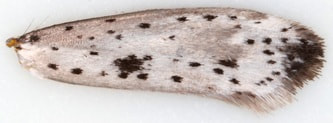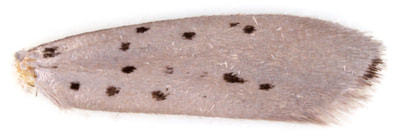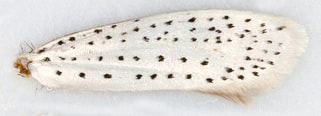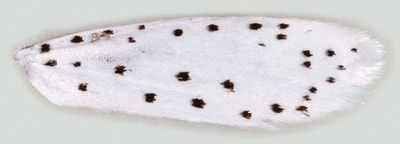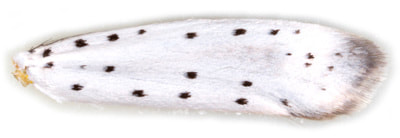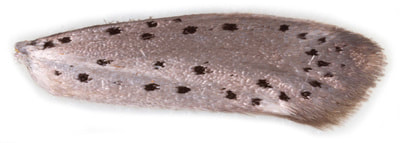Identification of Yponomeuta species |
Head smooth or rough-scaled, frons smooth; Proboscis developed
Antenna ¾ length of forewing; simple at base, weakly serrate beyond basal quarter, minutely ciliate; scape with or without pecten
Labial palp moderate, curved, ascending; S2 somewhat rough ventrally; S3 =/> S2
Forewing broad, discal cell long, almost reaching 5/6; white or whitish with longitudinal rows of black spots
Hindwing as long as forewing, elongate-ovate; hyaline space between cell and base
Antenna ¾ length of forewing; simple at base, weakly serrate beyond basal quarter, minutely ciliate; scape with or without pecten
Labial palp moderate, curved, ascending; S2 somewhat rough ventrally; S3 =/> S2
Forewing broad, discal cell long, almost reaching 5/6; white or whitish with longitudinal rows of black spots
Hindwing as long as forewing, elongate-ovate; hyaline space between cell and base
Typically Yponomeuta species are small and white with rows of black dots.
Three species from other families have a similar pattern: Ethmia dodecea (Dotted Ermel) and Ethmia terminella (Five-spot Ermel) [Ethmiidae] are similar in size to Yponomeuta species; the former has much larger black spots and the latter has a row of terminal interneural black dots;
Myelois circumvoluta (Thistle Ermine) [Crambidae: Phycitinae] is much larger.
Three species from other families have a similar pattern: Ethmia dodecea (Dotted Ermel) and Ethmia terminella (Five-spot Ermel) [Ethmiidae] are similar in size to Yponomeuta species; the former has much larger black spots and the latter has a row of terminal interneural black dots;
Myelois circumvoluta (Thistle Ermine) [Crambidae: Phycitinae] is much larger.
Y.sedella is the smallest of the Yponomeuta species; it is grey, the terminal area of the forewing lacks dots and the terminal cilia in the costal half of the forewing have black bases forming a distinct black mark.
Y.plumbella has a much more obvious black terminal mark and a large black spot at ~2/5 between the two dorsal rows of black dots
Y.irrorella is similar to Y.plumbella but the large black spot is replaced by a grey spot and the terminal area lacks a distinct black mark
Y.evonymella has 5 or 6 rows of black dots with more than 8 dots in the most dorsal row.
Y.padella/cagnagella/malinellus/rorrella are all very similar with 3 or 4 rows of black dots on a white or whitish ground colour and not more than 8 dots in the most dorsal row. Differences in forewing pattern do not distinguish the species with absolute certainty.
Y.rorrella has a pattern of grey suffusion that leaves the dorsal half and a pre-terminal costal patch white.
Y.cagnagella has no grey suffusion of the forewing ground colour, including the terminal cilia, being entirely white apart from the black dots.
Y.malinellus has contrastingly grey terminal cilia.
Y.padella has a variable amount of grey suffusion and the terminal cilia are the same colour as the terminal area of the wing.
Y.rorrella shows 6-8 black dots in each of the 2 dorsal rows (~8 above the fold, 6-8 below the fold), while Y.padella/cagnagella/malinellus show 4-7 dots in these rows (4-6 above fold, 4-7 below fold).
MBGBI3 suggests (after Povel, 1984) that the number of antennal segments can be used: Y.padella 51-57, Y.mallinellus 50-56, Y.cagnagella 56-65. So individuals with 50 antennal segments should be Y.mallinellus, those with 51-55 could be either Y.padella or Y.mallinellus, with 56 segments it could be all three species, with 57 segments Y.padella or Y.cagnagella and with 58-65 segments Y cagnagella.
There are no reliable genital differences between these 4 species
Y.plumbella has a much more obvious black terminal mark and a large black spot at ~2/5 between the two dorsal rows of black dots
Y.irrorella is similar to Y.plumbella but the large black spot is replaced by a grey spot and the terminal area lacks a distinct black mark
Y.evonymella has 5 or 6 rows of black dots with more than 8 dots in the most dorsal row.
Y.padella/cagnagella/malinellus/rorrella are all very similar with 3 or 4 rows of black dots on a white or whitish ground colour and not more than 8 dots in the most dorsal row. Differences in forewing pattern do not distinguish the species with absolute certainty.
Y.rorrella has a pattern of grey suffusion that leaves the dorsal half and a pre-terminal costal patch white.
Y.cagnagella has no grey suffusion of the forewing ground colour, including the terminal cilia, being entirely white apart from the black dots.
Y.malinellus has contrastingly grey terminal cilia.
Y.padella has a variable amount of grey suffusion and the terminal cilia are the same colour as the terminal area of the wing.
Y.rorrella shows 6-8 black dots in each of the 2 dorsal rows (~8 above the fold, 6-8 below the fold), while Y.padella/cagnagella/malinellus show 4-7 dots in these rows (4-6 above fold, 4-7 below fold).
MBGBI3 suggests (after Povel, 1984) that the number of antennal segments can be used: Y.padella 51-57, Y.mallinellus 50-56, Y.cagnagella 56-65. So individuals with 50 antennal segments should be Y.mallinellus, those with 51-55 could be either Y.padella or Y.mallinellus, with 56 segments it could be all three species, with 57 segments Y.padella or Y.cagnagella and with 58-65 segments Y cagnagella.
There are no reliable genital differences between these 4 species
Key to Yponomeuta |
||
Conspicuous black spot at 2/5 |
black terminal mark |
Y.plumbella |
Conspicuous grey spot at 2/5 |
grey suffusion of terminal area |
Y.irrorella |
Small and grey |
no black dots in terminal area |
Y.sedella |
5-6 rows of black dots |
>8 dots in most dorsal row |
Y.evonymella |
3-4 rows of black dots |
up to 8 dots in most dorsal row |
Y.padella/cagnagella/malinellus/rorrella |
Separation of Y.padella/cagnagella/ malinellus/rorrella |
Grey suffusion |
Black dots in dorsal and subdorsal rows |
Antennal segments |
Y.cagnagella |
None |
4-6; 4-7 |
56-65 |
Y.malinellus |
Terminal cilia (contrasting with white terminal region) |
4-6; 4-7 |
50-56 |
Y.padella |
Variable; terminal cilia concolorous with terminal region) |
4-6; 4-7 |
51-57 |
Y.rorella |
Costal half except preterminal patch |
~8; 6-8 |
